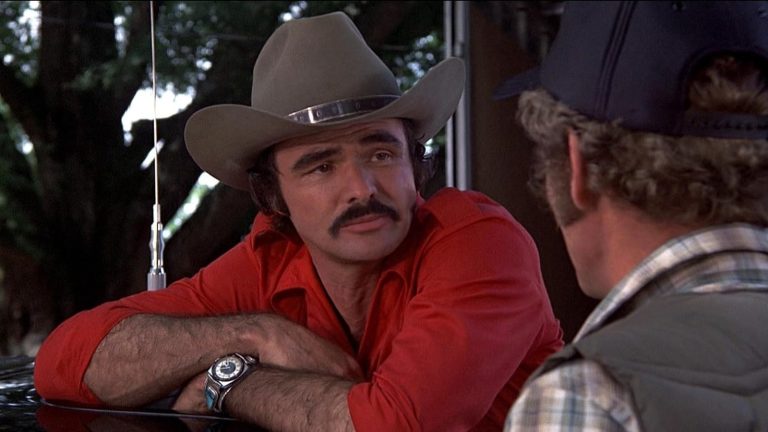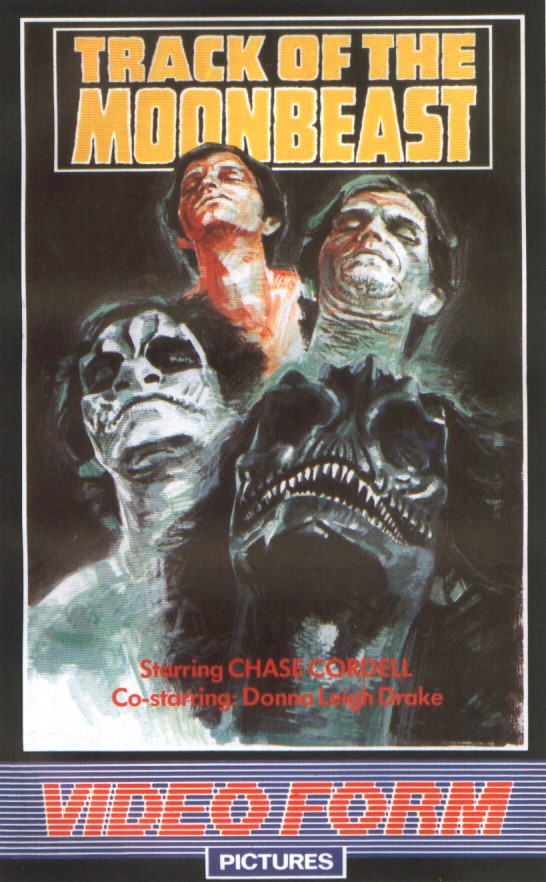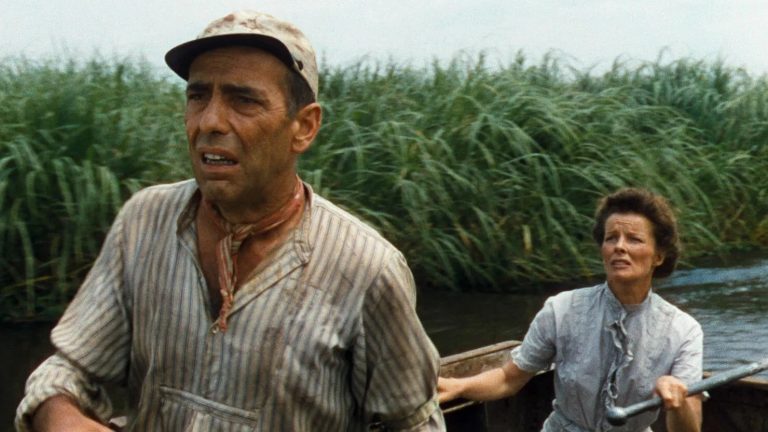

Rivers in movie could be highly effective symbols. As bodily options, they’re each setting and setting, generally an antagonist, generally a complete character. They are often engines of plot all to themselves.
Typically a river is a objective, or a way to objective. Typically it’s an impediment which guards the objective and should be overcome.
All this might be mentioned for different geographical options akin to mountains or oceans (and people could get their very own articles sometime). However a river gives a novel issue of motion — inexorable, practically uncontrollable motion, all the time in a single route. There isn’t any “downstream” at sea.
On this means, river movies are just like prepare movies (additionally topic of a future article), however trains lack the essential component of wildness. To at least one diploma or one other, rivers convey with them an elemental hazard and unpredictability, which throws gasoline on no matter plot you is perhaps having on the time.
The beneath ten movies — ranked by the Flickchart globals — greatest exemplify the advantages of tales set on a transferring vein of water.
For the needs of this text, we’re limiting our dialog to river journeys. Movies akin to The River or A River Runs Via It don’t make (in our opinion) full sufficient use of the river qua river as a cinematic constraint and plot mechanism. Quite, these are tales that occur to happen in or close to rivers.
We would like the river to be taking us someplace, whether or not the characters need it to or not.
Chime in within the feedback if we missed an apparent one.

Ask any American about tales (of any medium) that happen on rivers, and they’re going to instantly consider Huck Finn (or possibly Tom Sawyer in the event that they’re confused). Huck and Jim on a raft on the Mississippi have change into a quintessential American picture: a ragged and rebellious semi-orphaned white boy and an escaped enslaved Black man, every on the lookout for freedom, every defining it in another way, and every serving to the opposite with lovable naivete.
Their adventures, ever-so-loosely coupled and the very definition of “picaresque,” illustrate completely the ability of river-based storytelling. The river is a vacation spot, a car, a assassin, a savior, a plot comfort, an impediment to be overcome, a political delineation, and an awe-inducing elemental backdrop for the characters to easily sit and ponder.
That mentioned, out of the various diversifications of this story in movie, this one, directed by Michael Curtiz, has the best rating on Flickchart, and it nonetheless solely barely breaks the highest ten. Regardless of its fame as a “basic”, it someway fails to transcend its time and place. But it surely encompasses a really nice river.

One of the remembered (if not precisely celebrated) films from the 90s’ temporary revival of the “monstrous nature” style. Together with Lake Placid and Deep Blue Sea, this movie, directed by Luis Llosa, was a part of an try (a profitable try, financially talking) to return to the Jaws-style blockbuster, this time with loads of Clinton-era CG gloss and earnestness.
The plot consists of J-Lo, Ice Dice, and Owen Wilson (triumvirate rulers of 90s popular culture), taking a rust-bucket boat down the Amazon the place they meet Jon Voight doing a horrible accent. What begins out as Creature from the Black Lagoon turns into extra like King Kong instances Lifeboat divided by subtlety and aesthetics.
The unlikable characters and inanity of the creature results finally sink the movie, however it should be heralded as a wonderful instance of an arduous river journey: the city-folk nature documentarians, hemmed in by the wilds that they dare to assert the suitable to mansplain; the inexorable liquid locomotive that drives them to the ultimate slithering confrontation; the river itself a type of serpentine antagonist; the titular snake a type of embodying spirit of all of the river’s wild and unknowable would possibly.

The River Wild, directed by Curtis Hanson, makes use of the river similarly as Huck and Jim did: concurrently a pervasive plot gadget and a metaphor. It largely works.
Gail (Meryl Streep) and Tom (David Strathairn) are having bother of their marriage. So to clear her head, she takes their son (Joseph Mazzello) and canine (Buffy) on a whitewater rafting journey down Idaho’s Salmon River. A visit which is first crashed by her nerd husband, after which by fugitives Kevin Bacon and John C. Reilly, who proceed to screw all the pieces up by kidnapping everybody.
Meryl Streep’s backstory is that she is a skilled whitewater information and has a deep historical past with this specific river. Within the first act, she is confronting the truth that her marriage is dissolving, and it’s a telling character selection that her technique of processing that is be to return to a violent, elemental panorama which presents a difficult-to-survive problem however one for which she has been skilled. In contrast to her marriage.
How many people do those self same kinds of issues? A self-imposed problem to remind us of no matter competence we do have, in a world that solely celebrates a tiny, boring set of capabilities? Video video games, neighborhood basketball, church choir, mannequin airplanes — adults are without end shrinking the taking part in subject right down to one thing smaller than Life Itself. And Meryl Streep’s character does no totally different.
However her “shrunken taking part in subject” simply occurs to be a strong, elemental, raging river. It’s right here that she’s going to play out her metaphorical battle in opposition to middle-age frustration and self-perceived impotence.

Our second “monster” movie on this record and the third involving a raft, Piranha was Joe Dante‘s try and make a Jaws also-ran, which just about unintentionally turned beloved in its personal proper.
The premise is that throughout the Vietnam Battle, one of many U.S. authorities’s brainstorms was to genetically engineer a species of piranha which might thrive in North Vietnam’s local weather. In typical authorities vogue, the venture was cancelled and deserted, leaving all of the fish in a concrete pool, simply ready for some idiots to unintentionally allow them to free into a close-by river.
What follows is a type of lazy, exposition-laden river chase as our heroes (a drunk information, a naïve skiptracer, and a burned-out scientist) try to stop the college of mutants from making it previous a dam and right into a youngsters’s summer season camp.
The river journey is, actually, solely a characteristic of the movie’s second act. However the river involves characterize not simply the conveyance to the following plot level, but in addition the titular monster. Our heroes, their Jeep destroyed, are pressured to journey upon the very factor that they have to get downstream to warn everybody about. That is highly effective irony, and it ensures steady shut contact between them and the lethal menace, which makes for a really tense and arduous scenario.

Typically the river takes a extra passive position within the plot. Typically it’s “merely” a setting the place the story takes place. However even then, the refined bottled-up power and inexorable motion ahead make their presence felt.
In Thirties Egypt, a bunch of British fancies, all in sometimes Christie-ian inter-tanglements, board a steamship for a vacation down the Nile River. Amongst them is famous Belgian detective Hercule Poirot, who is useful when our bodies begin dropping with inscrutable motives and particulars.
This movie was remade in 2022, however we give delight of place right here to this one (directed by John Guillermin), which is larger ranked. Peter Ustinov turns in a beautiful efficiency, however one is reminded that his interpretation of the character stays comparatively steady whatever the setting.
It’s one thing of a staple of the Poirot tales for there to be some constraining power on the homicide scene and suspects; it’s the engine that drives the strain. In any case, how is Loss of life on the Nile all that totally different in setting than Homicide on the Orient Specific?
So this movie’s presence in our record, on the very least, identifies the river journey as a crackerjack setting for parlor mysteries. Like we’ll see in Apocalypse Now, the river itself truly does little or no to immediately assist or hinder our heroes. It’s merely the medium, chugging alongside, robust however passive, it’s function being primarily to ensure no one can merely stroll away.

Leaping over a thousand locations within the International Rankings, Deliverance, directed by John Boorman, catapults us into the “status” part of our record. Deliverance demonstrates simply how highly effective rivers could be in a movie, each actually and metaphorically.
4 males, city-dwelling bros with an idealistic view of the world outdoors the Atlanta metro space, got down to take a canoe journey down the Cahulawassee River, a gesture of return-to-nature in an period that (for those who can think about it) was quickly consuming inexperienced areas within the identify of progress and capitalism.
What they discover is that the scenario is worse than they thought: They’ve change into too separated from the atavistic fact lived by the human male within the wild. They underestimate what should be executed to really return to a state of nature. They be taught too late that there could be no vacationers.
All through the course of this realization, the river is their chariot. Scenes and moments and vignettes are performed out in little dreamlike chunks, throughout the entire spectrum of expertise from the chic to the horrific, like an It’s a Small World journey from hell.
And identical to life (and identical to It’s a Small World), the one means out is thru. Their solely hope is to proceed downstream, to totally decide to reaching no matter “deliverance” is meant for them. It can’t be resisted. You’d have higher luck damming the Cahulawassee.

John Huston‘s The African Queen is a basic mixing of genres. Half journey, half colonial culture-clash, half mismatched romantic comedy, half determined wartime heist, the movie nonetheless manages to carry itself collectively round an industrial-strength backbone of Bogart–Hepburn chemistry and a transparent, easy story.
In 1914 German East Africa, an effete British missionary groups up with with a brutish Canadian steamboat captain to flee from the explosion of violence that marks the beginning of the Nice Battle.
Their avenue of escape is the (fictional) Ulanga River, the apotheosis of all cinematic rivers in all places: raging whitewater in some areas, stagnant and swampy in others, in nonetheless others lush and teeming with life.
This assortment of riparian sides fuels the river’s metaphor for the considerably reluctant burgeoning romance on board. The completion of the river’s journey in its terminating lake coincides with the end result of our heroes’ courtship, in addition to the conclusion of their improvised naval mission.
Think about how much less satisfying it might be if the ultimate act came about at merely another spot downstream. No, for this story, the plot and the river should observe the identical course, all the way in which to the tip.

Werner Herzog‘s Fitzcarraldo is NOT most well-known for being a couple of boat on a river. It’s well-known for being a couple of boat NOT being on a river.
Fitzcarraldo (Klaus Kinski) is an Irish expatriate in Peru, one other within the swarm of overseas rubber exploiters that flooded the area within the early twentieth century. However for Fitz, it isn’t about rubber and even cash for its personal sake. Quite it’s the means by which to convey opera, his one true ardour, to the backwater metropolis of Iquitos.
He convinces himself that, as a result of topography of the river system and the situation of the remaining rubber claims, his greatest hope for achievement includes portaging his 320-ton steamship throughout two kilometers of hilly jungle to a distinct river.
The actual life Iquitos is the world’s largest non-island metropolis which can’t be reached by street. Till the invention of air journey, the rivers (the Amazon, the Nanay, and the Itaya) had been the street.
This cultural and geographical context is required with a view to even vaguely strategy understanding the headspace that drives the characters on this movie. A novel model of insanity grips Fitzcarraldo, the sum complete of greed, cultural homesickness, and the complicated arduousness that pervades the straightforward act of survival in Peru’s weird river kingdom.
Along with its well-known “undoubtedly not a river” sequence, this movie does have a number of fascinating sequences on the river itself. However we’re primarily together with it in our record right here as a result of it shines a novel mild on how the each day truth of arduous river journeys can devastate the already-threadbare coherence of human society and the soul.

In director Werner Herzog’s second entry on this record, the river (as soon as once more the Amazon) is forged because the no-man’s-land the place the forces of the Previous and New Worlds meet. The European hubris concerning the invincible, inevitable march of Christian colonialism finds itself dashed in opposition to a wild wall of water, jungle, and illness.
The movie tells the (largely) true story of a Sixteenth-century cadre of conquistadors, monks, and noblewomen who bushwhack their means although the South American jungle seeking El Dorado.
They construct rafts to hold them and their horses and cannons, pondering that it will ease their journey. However the disconnection from land society, in addition to the pressures of easy survival, exacerbate the inherent insanity and greed within the males, particularly their ersatz chief Aguirre (as soon as once more the indominable Klaus Kinski).
What one should take into accout all through this ordeal, whilst we watch the river slowly torture the occasion to dying, we all know that finally, in the actual world, relying how you retain rating, the Spanish received. The precise Conquistadors, aided by illness and luck, had been for probably the most half profitable in utilizing Euro-Christian tradition to bludgeon South American aboriginal cultures into, at greatest, displacement.
Regardless of all the strife and horrors we see visited upon the White Devils, we all know it’s going to haven’t any vital dissuasive impression. The river and its personal rallied forces of illness and luck will be unable to carry the invaders off. All that can occur is that a couple of of them will probably be made to pay.

On the high of our record is a movie often regarded as a “Vietnam” movie, however through which the warfare is definitely only a backdrop, a colourful and concrete setting for a psychedelic dialog concerning the nature of humanity and conscience. All powered by the darkish majesty of the (fictional) Nung River.
In 1969, a burned-out Military covert operator (Martin Sheen) is ordered to assassinate a rogue particular forces officer (Marlon Brando) who has “gone native” and is being worshipped as a god.
Primarily based on Conrad’s The Coronary heart of Darkness, the story is structured as a collection of set items by way of which Captain Willard and his Navy escorts should cross as they putt-putt their means from the relative mild and “odd” madness of contemporary warfare, into realms a lot darker and weirder.
Precisely how a lot of what we see on the display screen is meant as literal is unclear. However the truth that this journey takes place by way of river is important to the movie’s impression. If Willard’s journey had taken place on foot, the dreamlike high quality wouldn’t have been achieved. Recall that Saving Non-public Ryan additionally tells the story of a semi-picaresque wartime journey, however its impact is way more prosaic and “non-dreamlike” (not an insult). That is no less than partly because of it going down nearly fully on foot.
The floating-over-water side of the technique of journey permits the journey to realize an unreal, hypnogogic high quality. This “post-conscious” framing pours gasoline on the symbolism and allegory with which the script is totally laden.
We love that that is the movie to spherical out our record, as a result of it could in truth be the head of this trope in motion.
Rivers in movie are extra than simply options of the panorama. When wielded appropriately, they allow and empower complete lessons of story and character, they usually broaden the cinematographers palette in ways in which would shock nobody who has witnessed an precise river’s magnificence and violence in particular person.
Our thesis is that rivers are greatest utilized to be ultimately a trial for our heroes – possibly not an outright impediment, however its plain energy needs to be delivered to bear in all its terrifying would possibly. It ought to in some sense make our hero’s journey (to make use of our chosen phrase) “arduous.”
We wish to see our hero sweat. Let’s make them battle a river.





